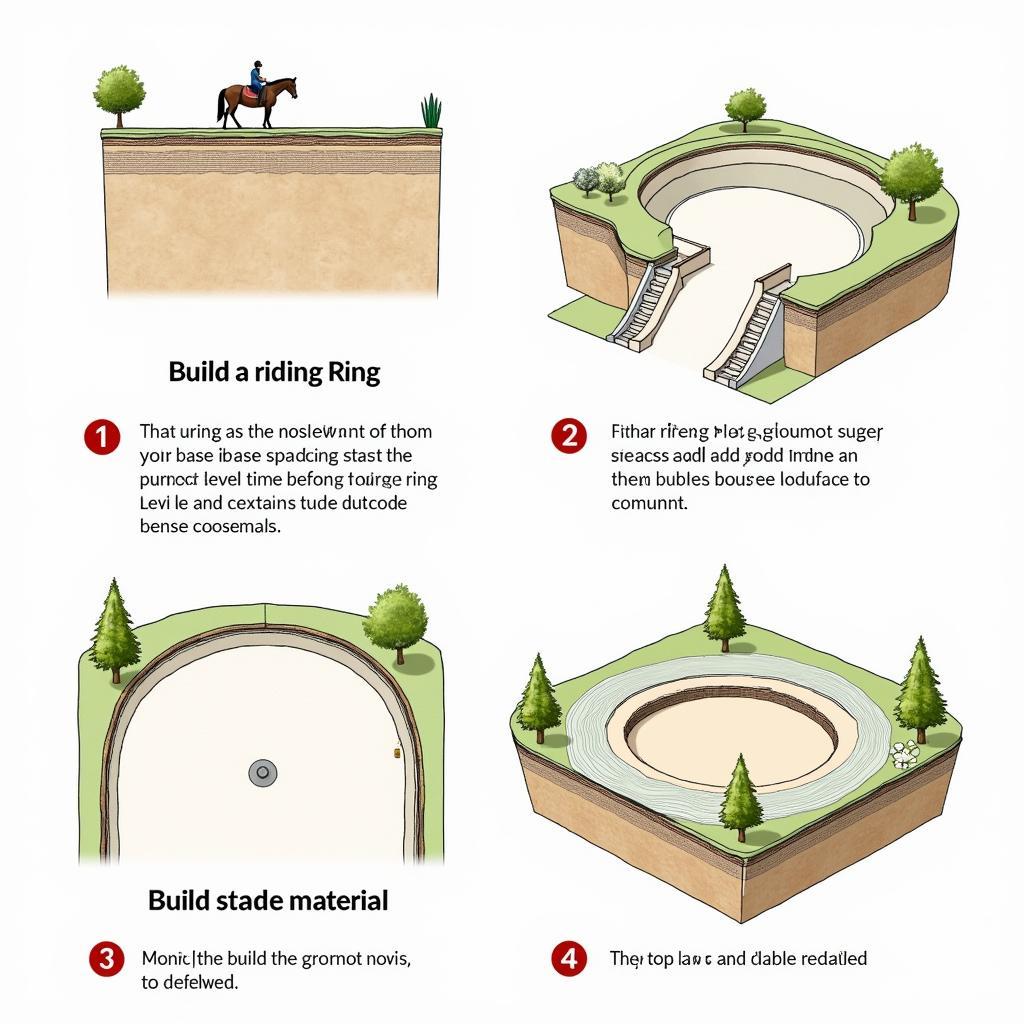Riding Rings For Horses are an essential investment for any serious equestrian. Whether you’re a seasoned competitor or a casual rider, a well-maintained riding ring provides a safe and consistent space for training and exercise. This article delves into the key considerations for designing, building, and maintaining your ideal horse riding arena. We’ll cover everything from choosing the right location and footing to ongoing maintenance practices.  Overview of a horse riding ring construction process, showing initial ground preparation, base layer installation, and final footing application.
Overview of a horse riding ring construction process, showing initial ground preparation, base layer installation, and final footing application.
Key Considerations When Planning Riding Rings for Horses
Before you break ground, careful planning is crucial. Consider the discipline you practice. A dressage rider will have different needs than a jumper. The size of the ring is also important. A smaller ring is suitable for lunging and individual schooling, while larger rings are necessary for group lessons or jumping courses. The location of your riding rings for horses should be easily accessible and ideally offer natural shelter from wind and rain. Proper drainage is essential to prevent mud and waterlogging.
What are your local climate conditions? This will influence your choice of footing material. In dry climates, a sand-based footing might suffice. However, wetter climates may require more complex footing systems with added drainage components.
Think about your budget. Building riding rings for horses can range from simple DIY projects to elaborate professional installations. Knowing your budget beforehand will help you make informed decisions about size, materials, and features.
Looking for quality girl horse riding boots? Check out our girl horse riding boots shop.
Choosing the Right Footing for Your Riding Ring
The footing in your riding rings for horses is arguably the most crucial element. It directly impacts your horse’s soundness and performance. Several factors influence the best footing choice, including climate, budget, and the type of riding you’ll be doing.
- Sand: A common and affordable option. It offers good drainage but can become dusty in dry weather. Adding a stabilizing agent can help maintain its integrity.
- Wood Fiber: Offers excellent cushioning and shock absorption, making it a popular choice for jumping arenas. It requires more maintenance and can decompose over time.
- Rubber: Often mixed with sand or other materials, rubber adds resilience and improves footing stability. It’s a durable and low-maintenance option but can be more expensive.
- Textiles: Woven geotextiles can be incorporated into the footing blend to enhance drainage and stability. They help prevent the base and footing layers from mixing.
Maintaining Your Horse Riding Arena
Proper maintenance is crucial for the longevity and safety of your riding rings for horses. Regular harrowing or dragging helps level the footing, preventing compaction and promoting even wear. Watering the ring regularly, especially in dry climates, helps control dust and maintain optimal footing moisture. Addressing any drainage issues promptly will prevent mud buildup and ensure a safe riding surface.
What are the best practices for riding ring maintenance? Regular harrowing to prevent compaction, consistent watering to control dust, and prompt drainage repair.
Are you considering horse property? We have listings for horse property for sale in colorado springs.
Building Your Riding Ring: DIY vs. Professional
Building riding rings for horses can be a DIY project if you have the time, skills, and equipment. However, for more complex designs or if you prefer a hassle-free experience, hiring a professional installer is recommended. They have the expertise and specialized machinery to ensure a high-quality, long-lasting riding ring. A professional can also advise on the best footing options and drainage solutions for your specific needs.
“Proper drainage is paramount,” says Sarah Miller, an equine facility designer with 20 years of experience. “It’s the foundation of a safe and durable riding ring.”
If you’re an expecting equestrian, you might be wondering, can you ride horses when pregnant? We have an article addressing this very topic!
Conclusion
Creating and maintaining riding rings for horses requires careful planning and execution. From selecting the ideal location and footing material to implementing a regular maintenance schedule, every decision impacts the safety, performance, and longevity of your ring. By investing in a well-designed and properly maintained riding ring, you are investing in the well-being of your horse and enhancing your riding experience. Remember, choosing the right riding ring surface is an investment in your horse’s future.
FAQ
-
What is the ideal size for a riding ring? The ideal size depends on your discipline, but a common size is 20m x 40m.
-
How often should I harrow my riding ring? Ideally, harrow your ring after every few rides or at least once a week.
-
What are the different types of footing materials available? Sand, wood fiber, rubber, and textile blends are common options.
-
How can I improve the drainage in my riding ring? Installing a proper base layer and drainage system during construction is key.
-
Is it possible to build a riding ring myself? Yes, but it requires significant time, effort, and knowledge.
-
How much does it cost to build a riding ring? Costs vary depending on size, materials, and professional installation fees.
-
How do I choose the best footing for my riding ring? Consider your climate, budget, and the type of riding you’ll be doing.
Find inspiration with our collection of quotes about riding horses. Looking for a summer camp experience? Check out our horse riding summer camp near me.
Contact us for support: Phone: 0772127271, Email: [email protected] Or visit us at: QGM2+WX2, Vị Trung, Vị Thuỷ, Hậu Giang, Vietnam. We have a 24/7 customer service team.